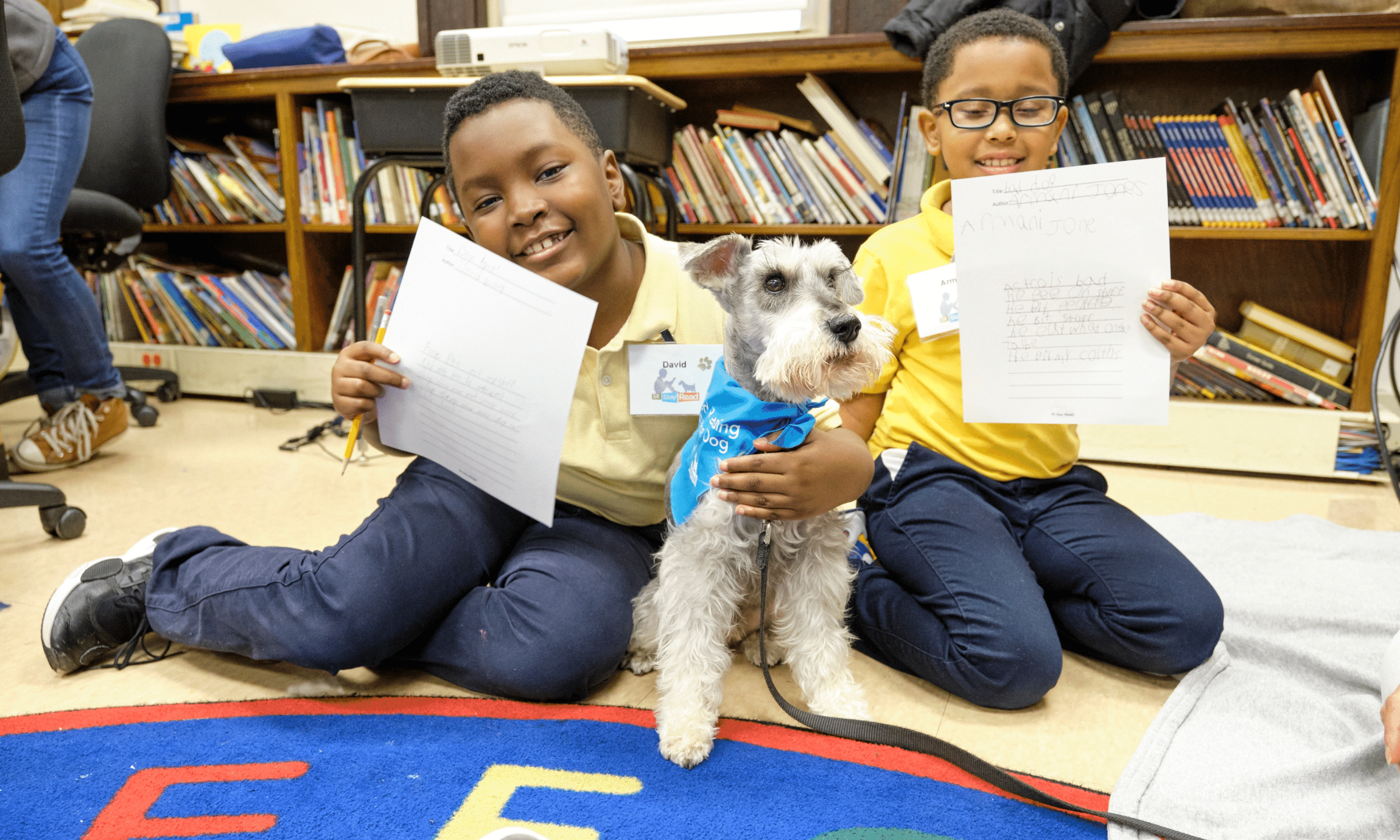
CURRICULA AND STANDARDS
SitStayRead provides year-round programming for K-3 students in the city of Chicago. We serve schools in neighborhoods where the student population is typically 90% from low-income households and 60% of third graders score below the national reading average.
Developed in partnership with local educators and faculty from the University of Illinois at Chicago Center for Literacy, the University of Chicago, DePaul University, and Northeastern University, our bilingual (English and Spanish) curriculum helps students learn to read in a fun, engaging way.
Program staff regularly review curricula for each level and are currently revising the second grade curricula with a lens focused on inclusion and belonging.
Team Effort
SitStayRead Program Staff along trained volunteer book buddies and dog teams lower the adult-student ratio in the classrooms we serve. This injection of attention to small groups of students allows for more individual reading support during each session. Classroom teachers, student aides and other school staff remain in the room and may facilitate or observe as needed.
Certified Reading Assistance Dogs help to create a positive social environment for readers to feel relaxed and excited about learning. Programs run for 6 weeks, and progress in classrooms we work with is notable as measured by our assessment tools outlined below.
5 CORE LITERACY STRATEGIES
Each SitStayRead kindergarten and first-, second-, and third-grade program runs for six consecutive weeks, meeting one hour per week in a classroom setting. Each visit contains five essential learning components:
1. Read-Aloud
Program staff begin by reading a book out loud to students. During the read-aloud, our staff and volunteers ask students questions about the storyline or illustrations and direct attention to the character’s emotions, behaviors, and strategies for addressing conflict.
2. Discussion
After completing the book, students process and share opinions about the story. They work to identify key story elements, sequence story events, or decipher the figurative language. These discussions help strengthen the students’ social and collaborative skills and allow them to organize their thoughts as they prepare to write their own stories.
3. Writing
Using the ideas generated during the book discussion, students start writing their own stories. Depending on the grade level, students may write creative stories, personal narratives, or poetry. Volunteer book buddies support students as they develop their stories. During the final visit, students receive a bound book containing all the stories they wrote over the course of the program.
4. Social-Emotional Learning
Program staff selects books that reflect the identities of our students, support positive social-emotional connections for students, and spark interest and joy in students. Our program books feature characters of color, showcase various family structures and neighborhoods, and introduce students to multiple writing styles, genres, and languages. We prioritize books created by BIPOC authors and illustrators so that students may see themselves reflected.
5. Developing the Dog-Human Bond
Our Certified Reading Assistance Dogs and dog team volunteer humans help students build confidence with their reading, as well as develop critical social-emotional skills such as empathy and self-control. These interactions deepen students’ understanding of how to care for and be safe around dogs, and for some provide a first experience with a fur-freind.
Ongoing Program Assessment
SitStayRead uses qualitative (teacher, student, and volunteer surveys) and quantitative (DIBELS, AIMSweb, and school/neighborhood demographics) data to analyze our programs.
Following each six-week program, partner teachers complete an evaluation to provide feedback on students’ literacy and social-emotional learning progress during and outside of our visits in the classroom.
Third-Party Evaluation
In 2017, SitStayRead partnered with the School of Education and the Center of School Intervention, Evaluation, and Training at Loyola University to conduct an evaluation of our curriculum.
According to the evaluation, SitStayRead first-grade students tend to outperform non-participant peers in reading and writing. SitSTayRead students also made greater gains in vocabulary, listening comprehension, and written expression.
The evaluation for SitStayRead second-grade students revealed their oral reading fluency was 47.8% greater than the average second-grade student during the same eight-week period. In the Elementary Reading Attitude Survey (ERAS), our students self-reported an increase in confidence while reading aloud in front of their peers.
We are currently in the process of partnering to conduct an updated evaluation of our curriculum for the 2024-25 school year.

